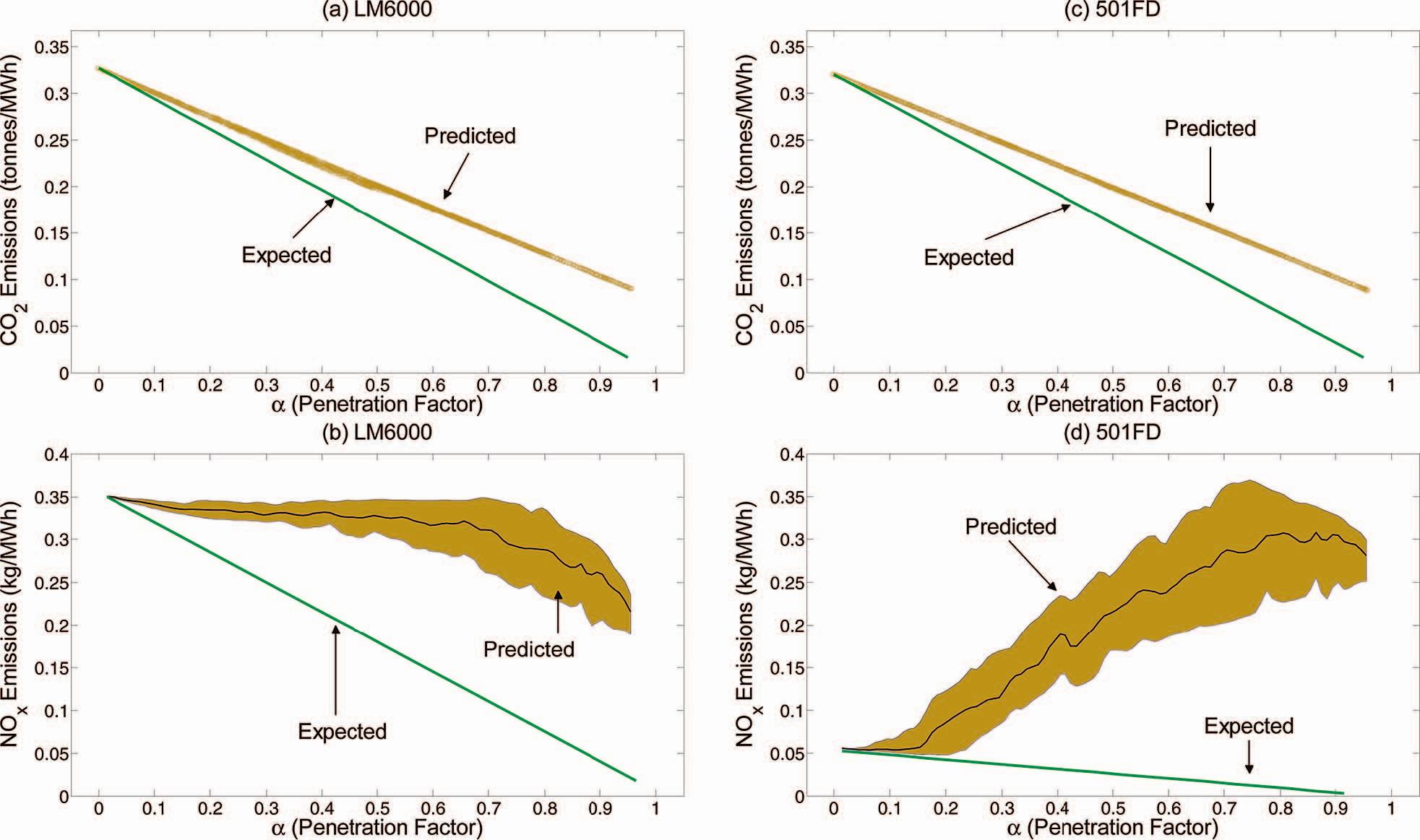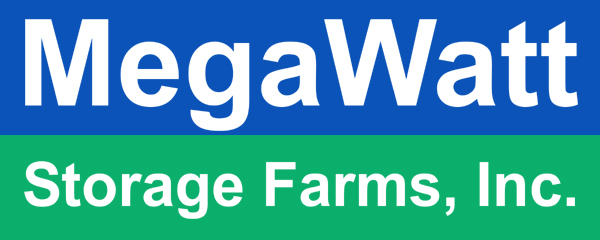
The Need for Electricity Storage
Storage on the electric grid is the only environmentally friendly way to reliably add large amounts of intermittent renewable generation, such as wind and solar. The challenge with intermittent renewables is that they have unpredictable outputs that can cause system instability and unreliability (e.g. blackouts when the wind stops blowing).
Texas has already experienced grid instability problems due to unexpected falloff in wind:
An abrupt loss of 1,200 megawatts of wind energy production on Feb. 26 [2008] that caught the Electric Reliability Council of Texas Inc. by surprise and forced it to declare emergency conditions underscores a critical policy issue, according to a key industry official.
ERCOT said the sharp drop in production during a three-hour period -- while overall electricity loads were increasing -- threatened the stability of the power grid and could have caused rolling blackouts.
... David Crane, President and CEO of New Jersey-based NRG Energy Inc., said the incident underscores the most critical energy policy issue facing the power industry.
"If a system can go unstable in the winter because 1,500 MW of expected wind turns into 400 MW wind and then fossil has to scramble to come online -- and several of our plants had to scramble to fill the gap -- that's a big issue and there's going to be a big debate," Crane said.
Houston Business Journal - Friday, February 29, 2008
California is facing similar challenges, as will the rest of the country as wind and solar usage grows beyond 10%. The chart below is from a California study on the irregular output of wind. It shows that the wind can drop off rapidly in the middle of the morning when the load is increasing as people arrive at work (Day 29). Storage can preserve energy when the wind is blowing, and feed that energy back into the grid when the wind stops.
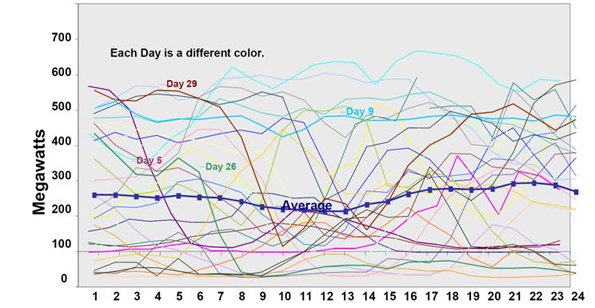
New types of energy storage technologies are needed that can help with the integration of large amounts of renewables and energy from intermittent resources.
Integration of Renewable Resources, CAISO Report, November 2007
Solar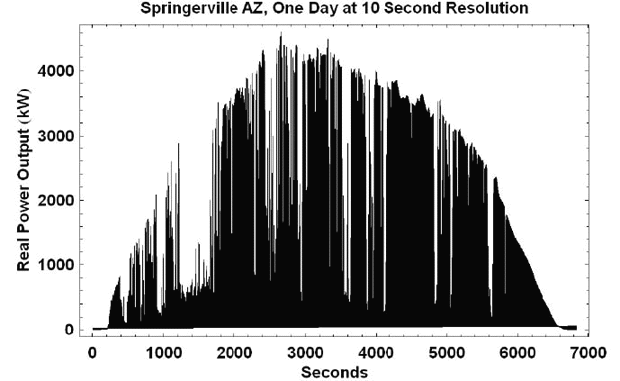
Solar photovoltaic power from the largest existing U.S. array, a 4.6 MW system in [Springerville] Arizona, also exhibits intermittency. Solar PV data at 10 second time resolution for one day are shown [above] ... Even in Arizona, the majority of days do not exhibit steady solar PV power.
Benefits of Storage
Storage provides multiple benefits:
-
Storage can provide regulation services (second-by-second addition of energy to / from the grid to keep total generation precisely matched to total load.)
-
Storage can provide load following (adjusting to shifts in wind and solar over timeframes of minutes to hours)
-
Storage can provide ramping (compensating for multi-hour changes in renewable outputs)
-
Storage responds instantly (under a second, versus fossil plants taking tens of minutes)
-
Storage adds no energy to the grid while it is standing by to protect against a drop-off in the output from renewables. (In contrast, fossil plants create energy and emit pollution when standing by at minimum settings - this energy is unwanted when renewable generation is high.)
-
Storage has zero emissions
-
Storage uses zero water resources
-
Storage is quiet
-
Storage located near loads can reliably provide power to a community during a blackout
-
Storage can eliminate the need for new transmission and distribution lines by making better use use of existing wires during slow times. For example, in the middle of the night, energy from remote wind generators can be moved close to the load, for use during peak periods the next day.
-
Storage can be quickly deployed, typically in a few quarters. In contrast, fossil plants take years (and are almost impossible to site in urban areas.) Transmission can take up to a decade to obtain right-of-ways and build.
-
Storage can be relocated if demographic shifts result in changed requirements
It is difficult to overstate the importance of energy storage. The efficiency and cost-competitiveness of renewable electricity generation and alternative-fuel vehicles could be significantly improved by the availability of low-cost, high-capacity storage. For example, because solar and wind power generation is intermittent — the sun and the wind are not constantly available — these systems require energy storage if they are to serve as a reliable supply of electricity throughout the day.
Storage is Essential for Green Benefits from Wind & Solar
Storage is essential if the green benefits of renewables are to be fully realized. It makes no sense to protect against a falloff in wind or solar output by running fossil fuel plants on idle 24 x 7, where their emissions are at their dirtiest. Using fossil fuel plants this way negates many of the green benefits of the wind and solar.
A study by Warren Katzenstein, and Jay Apt of Carnegie Mellon University predicts that the CO2 and NOx emissions will fall well short of the savings one might expect for wind penetration factors from 0% to 100%, when fossil plants are used to smooth the wind output. In particular, the NOx pollution remains pretty much unchanged if the fossil plant is based on the LM6000 turbine, and the NOx emissions actually get worse as more wind is added, if the fossil plant uses a 501FD turbine.
A system with renewables that uses LM6000 turbines for fill-in power achieves 76-79% of the expected CO2 emissions reductions and 20-45% of the expected NOx emissions reductions. An emissions displacement analysis would have overestimated emissions reductions by 23% for CO2 emissions and by 55-80% for NOx emissions. Similar penalties of 24% are incurred for 501FD CO2 emissions reductions, but NOx emissions increase by factors of 2-6 times the amount emissions were expected to be reduced, because of the unoptimized NOx performance of the 501FD system below 50% power. [boldface added by MegaWatt for emphasis]
CA Needs 4 GW by 2020 (5% of peak demand)
MegaWatt's analysis of the California grid indicates that about 4 GW of storage (about 5% of the peak demand) will be needed to support the 33% RPS goal of 2020. We have presented this at multiple conferences and have been told by industry analysts, utility executives and government officials that this is in line with their own estimates. We believe 1 GW is needed in Northern California, 2 GW in the LA area, and 1 GW in San Diego.
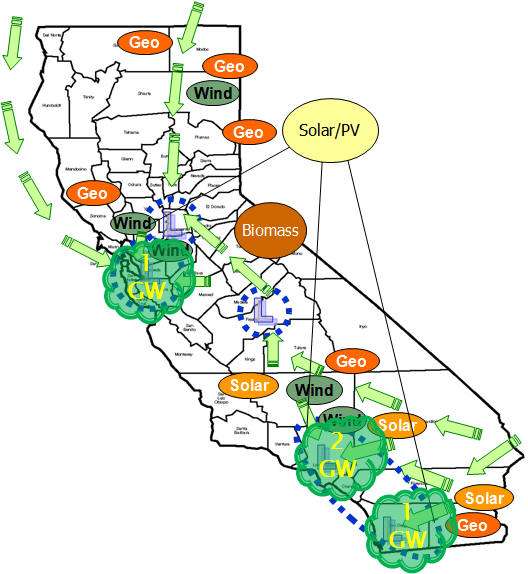
If we are to achieve these targets, we need to start working now to build 0.5 GW/year (500 MW/year) rate of battery production capacity and storage deployment just for California. The total USA needs will be far larger.
Note that 1 GW of storage can provide 2 GW of adjustable range, since it can vary from charging at 1 GW to discharging at 1. In contrast, the range of a 1 GW fossil plant, from its minimum operating point to its maximum output, is less than 1 GW. While the DOE report cited below estimates 50 GW of fossil plants is needed by 2030 to support a 20% RPS from wind, a very large part of this could be provided by storage.
The July 2008 U.S. Department of Energy (DOE) report "20% Wind Energy by 2030: Increasing Wind Energy’s Contribution to U.S. Electricity Supply" discusses the scenario in which integration of 300 gigawatts (GW) of wind energy into the U.S. grid is achieved. To deal with the variability of the wind energy output, approximately 50 GW of new peaking plant gas turbines would be used to supplement or compensate for the variability of the wind power’s output. Energy storage could serve a portion of this needed capacity.
Government Support for Storage
The success of green programs often depends on government mandates because the benefits, while economically attractive at a societal level, are distributed across the population and thus difficult to capture in a specific transaction. This was true with automobile emissions legislation. It was also true with renewables, where Renewable Portfolio Standards and tax incentives were needed to motivate deployment of wind and solar. Similarly, Demand/Response programs required government mandates to encourage formation of demand/response aggregators. These aggregators emerged to economically combine the small energy savings of multiple smaller users into grid-scale benefits.
Storage can provide clean, green, economical integration of wind and solar. But today there are limited financial incentives to install storage - certainly not enough to deploy the tens of GWs needed to meet our renewable goals.
A Green Standard of 5% Storage
What is urgently needed is a government mandate for installation of storage. We believe a reasonable standard is that storage be built to meet 5% of the peak system demand in California, in support of the 2020 RPS standard of 33% renewables. Deployment of this storage would facilitate expansion of renewables to meet RPS goals, while ensuring both dependable delivery of power and recognition of the full green benefits of the renewables. This storage would also reduce the need for new transmission and distribution.
"Large scale, megawatt-level electricity storage systems, or multiple, smaller distributed storage systems, could significantly reduce transmission system congestion, manage peak loads, make renewable electricity sources more dispatchable, and increase the reliability of the overall electric grid."
